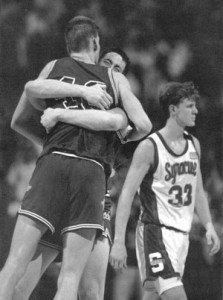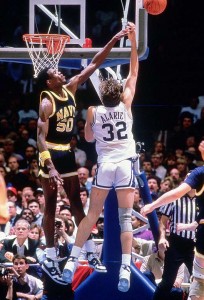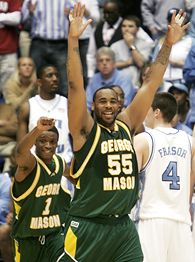The Colonial Athletic Association: The NCAA Tournament’s Giant Slayer

The 1991 NCAA Tournament win by Richmond over Syracuse marked the first time a 15 seed had ever defeated a number two seed.
When the NCAA Division I men’s basketball tournament begins later this month there will be lots of talk about Cinderella’s and which previously unknown teams from obscure conferences will shatter the Final Four dreams of schools from top-tier leagues.
For more than a quarter century, schools from one mid-level conference have set the standard for crashing the dance during March Madness.
Based in the mid-Atlantic region of the East Coast, the Colonial Athletic Association (CAA) has created an impressive resume of NCAA Tournament upsets.
Even before the league officially formed in 1985, some of its original members were harassing the “big boys” during the NCAA Tournament.
Between 1981 and 1983, James Madison University (as a member of the CAA predecessor the ECAC South), made three consecutive trips to the NCAA Tournament and each season knocked off a big conference opponent. Their victims were all marquee programs in West Virginia, Ohio State and Georgetown.
JMU also nearly pulled off what would have gone down as one of the biggest upsets in tournament history as they gave eventual National Champion North Carolina all they could handle during the second round of the 1982 NCAA Tournament. UNC needed a controversial charge call on JMU in the final minute to pull out a 52-50 victory.
The University of Richmond (a member of the ECAC South and then a CAA member from 1985-2001) is now known as the only team in NCAA Tournament history to win games as a 12, 13, 14 and 15 seed, however, in 1984 they were a national unknown when head coach Dick Tarrant led the Spiders into the tournament.
Which Non-BCS Conference has the Strongest Men's Basketball in 2010?
- Atlantic 10 (87%, 53 Votes)
- Colonial Athletic Association (7%, 4 Votes)
- Mountain West (3%, 2 Votes)
- Conference USA (2%, 1 Votes)
- WAC (2%, 1 Votes)
- Horizon (0%, 0 Votes)
- West Coast (0%, 0 Votes)
Total Voters: 61
After demolishing Rider 89-65 just to make it into the field, the Spiders shocked Charles Barkley and the Auburn Tigers 72-71 in the opening round. They then gave Bobby Knight’s Indiana Hoosiers everything they wanted before falling 75-67.
You need look no further than the first official season of the CAA (1985-86) to get a sense of the caliber of player, coach and performance that has been part of the conference over the last 25 years.

David Robinson and Navy reached the NCAA Tournament Elite Eight in 1986.
Leading the way was junior center David Robinson from the U.S. Naval Academy (a CAA member from 1985 to 1991) who earned the first of his consecutive CAA Player of the Year honors in 1986. Other first team selections included future NBA players in Johnny Newman (Richmond) and Brian Rowsom (UNC-Wilmington).
Tarrant was honored as the CAA Coach of the Year in 1986 after leading Richmond to a 23-7 record and third straight trip to the NCAA Tournament. Other notable coaches during the initial year of the CAA were Navy Coach Paul Evans (who went on to lead Pittsburgh to five NCAA Tournament appearances in eight years as head coach) and Joe Harrington from George Mason (who later coached at Long Beach State and the University of Colorado).
Led by Robinson, fellow first team All-CAA selection Vernon Butler and future Tulsa coach Doug Wojcik, Navy claimed the CAA regular season and conference tournament titles. They made a run to the Elite Eight of the NCAA Tournament with victories over Tulsa, Syracuse and Cleveland State before falling to eventual finalist Duke.
Just two years later, Richmond cemented the CAA’s reputation as a giant killer with an opening round victory over the defending NCAA Champion Indiana Hoosiers. The Spiders also defeated Georgia Tech before falling to Temple in the round of 16.
The Spiders continued to be a thorn in the side of big-time programs in the coming years.
In 1991 they became the first 15-seed to knock off a number-two seed with an upset of Big East regular season champion Syracuse. As a 14th seed in 1998, the Spiders defeated third seed South Carolina.
Though both Richmond and Navy are no longer part of the conference, other schools have stepped up to fill the role of David to basketball’s Goliaths.
Old Dominion upset Villanova in three overtimes in the 1995 NCAA Tournament and UNC Wilmington defeated the University of Southern California in overtime during the 2002 tournament.
But the best was still yet to come.

George Mason defeated three former NCAA Champions on their way to the 2006 Final Four.
In 2006 George Mason, earned a rare at-large bid to the tournament and proved that they belonged with the big boys. They opened the tournament with a 75-65 victory over sixth seeded Michigan State and then surprised third seeded North Carolina and seventh seed Wichita State to reach the Elite Eight against top seed Connecticut.
George Mason reached the Final Four with a shocking 86-84 overtime victory over the Huskies. The win capped a run in which the Patriots defeated three teams with National Championships during the decade.
Their amazing run ended in the national semifinals with a 73-58 loss to the eventual champion Florida Gators.
The next season, Virginia Commonwealth continued the upset tradition with a 79-77 victory over Duke to mark the first opening round tournament loss for the Blue Devils in 11 years.
Over the years, the CAA has been a harbinger both for young coaches on their way to greatness and for veteran coaches looking for one additional shot at glory.
Among the coaches who have prowled the sidelines for CAA schools include Lefty Driesell (James Madison), Sonny Smith (Virginia Commonwealth), Oliver Purnell (Old Dominion), Paul Westhead (George Mason), Rick Barnes (George Mason), Jerry Wainwright (UNC-Wilmington), Anthony Grant (Virginia Commonwealth), Jeff Capel III (Virginia Commonwealth) and Eddie Payne (East Carolina).
While Robinson, Newman and former East Carolina star Blue Edwards had the most distinguished professional careers among players from the CAA, other former players have enjoyed success in the NBA or playing professionally in Europe.
As the CAA celebrates their 25th Anniversary, the league looks poised to add new big names to the already impressive list of schools that have been knocked out by the CAA.
William & Mary, traditionally among the weakest teams in the conference, is enjoying their finest season in a decade and defeated a pair of tournament bound ACC teams, Wake Forest and Maryland, on the road earlier this season. Other wins by CAA clubs over potential NCAA Tournament teams includes Old Dominion over Georgetown and Charlotte, Northeastern over Utah State and both Virginia Commonwealth and William & Mary over the University of Richmond.
Whether the CAA gets two NCAA bids or only the automatic bid, no team will want to face a school from the conference that has proven time and again that once you get to the NCAA Tournament anything can happen.









